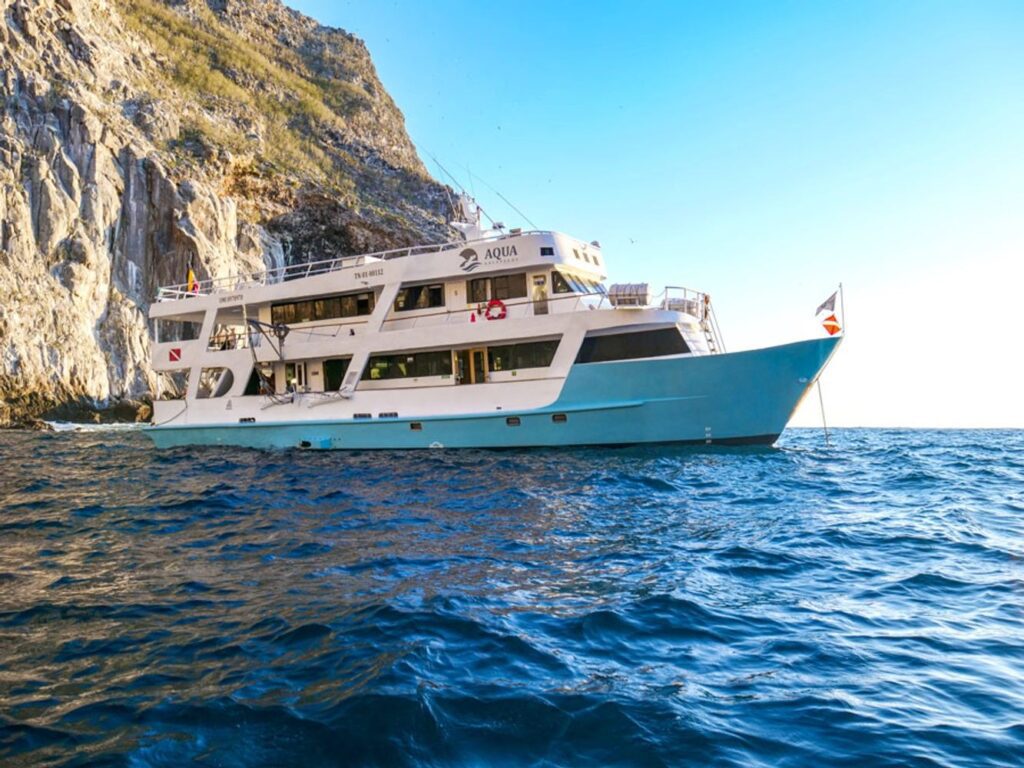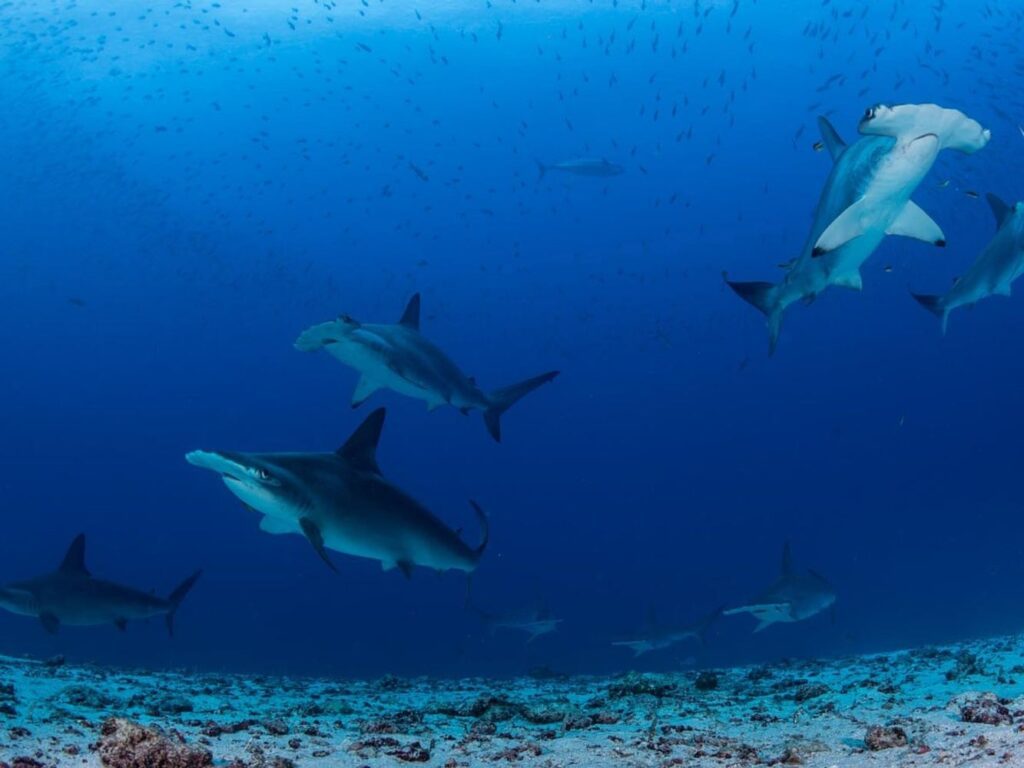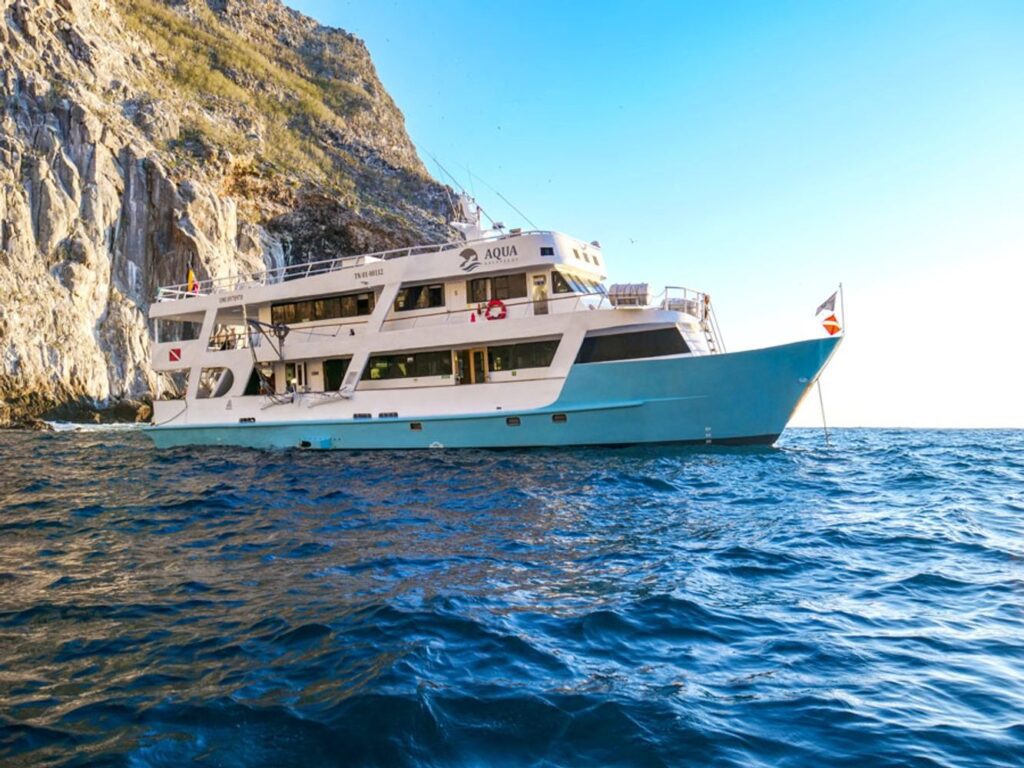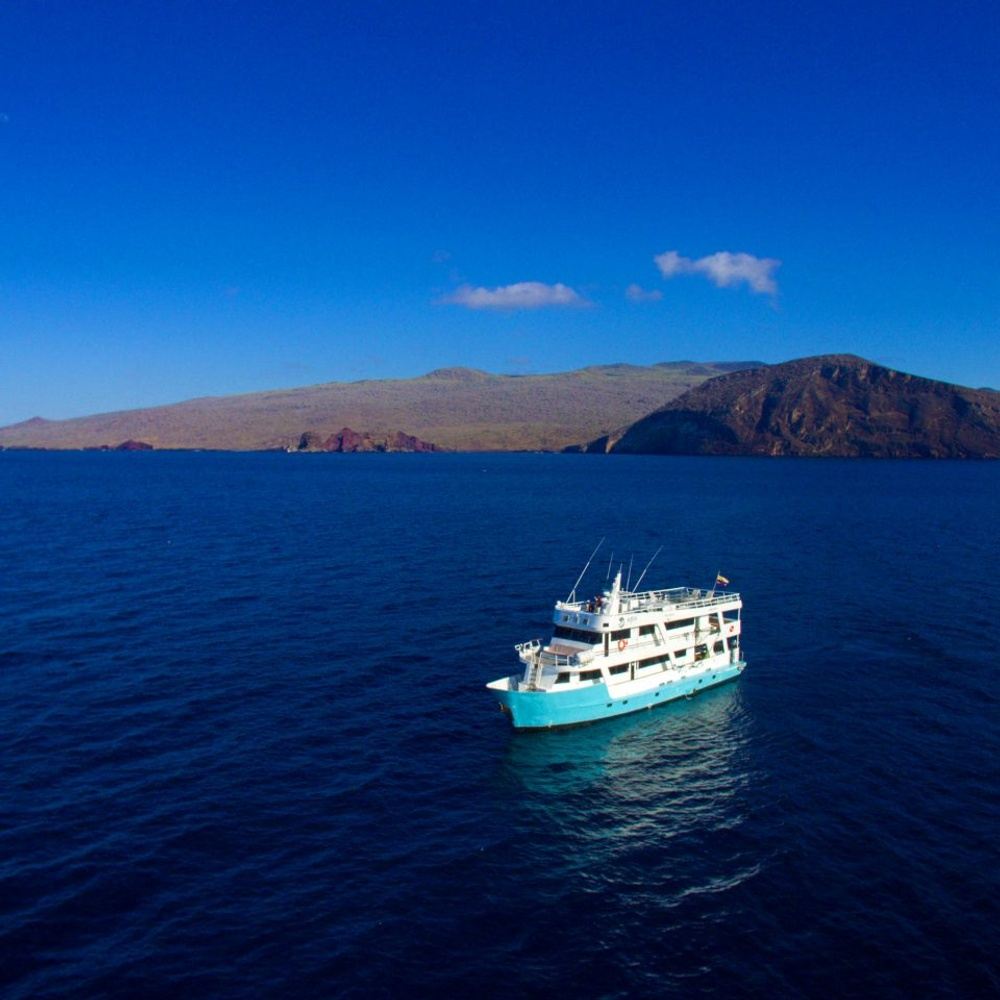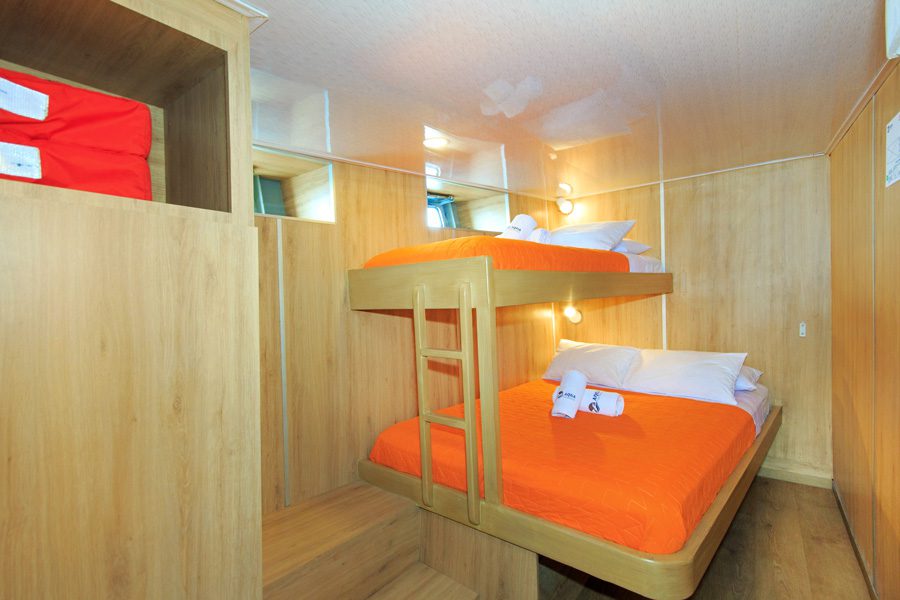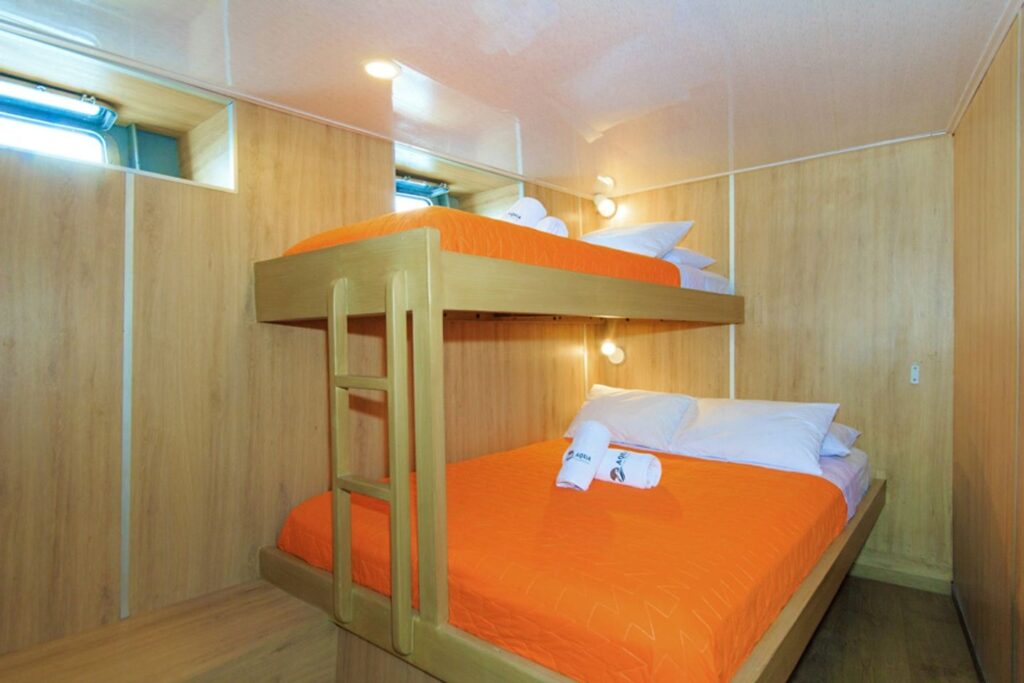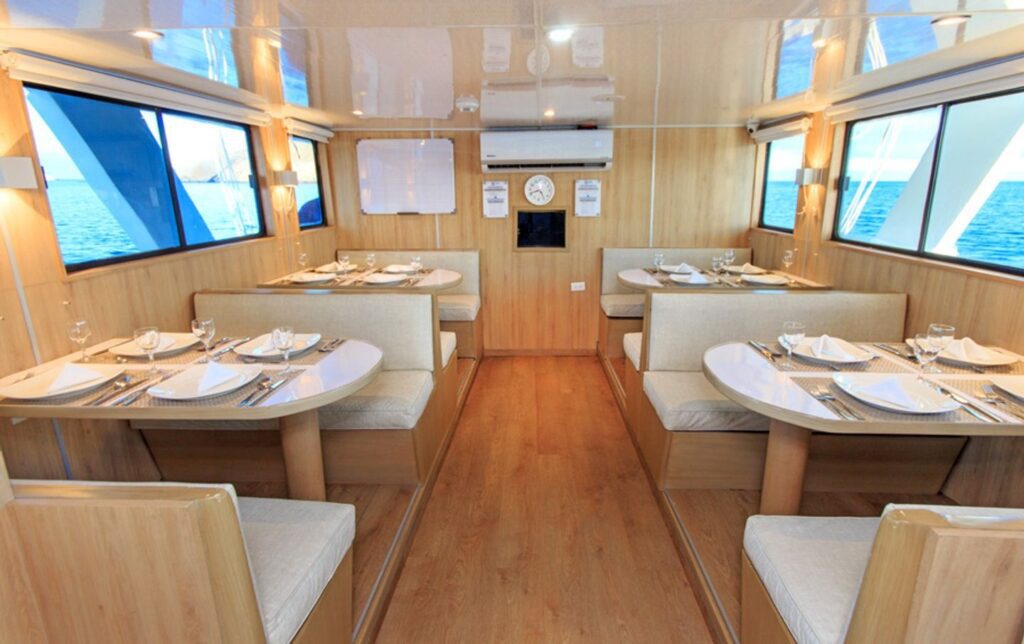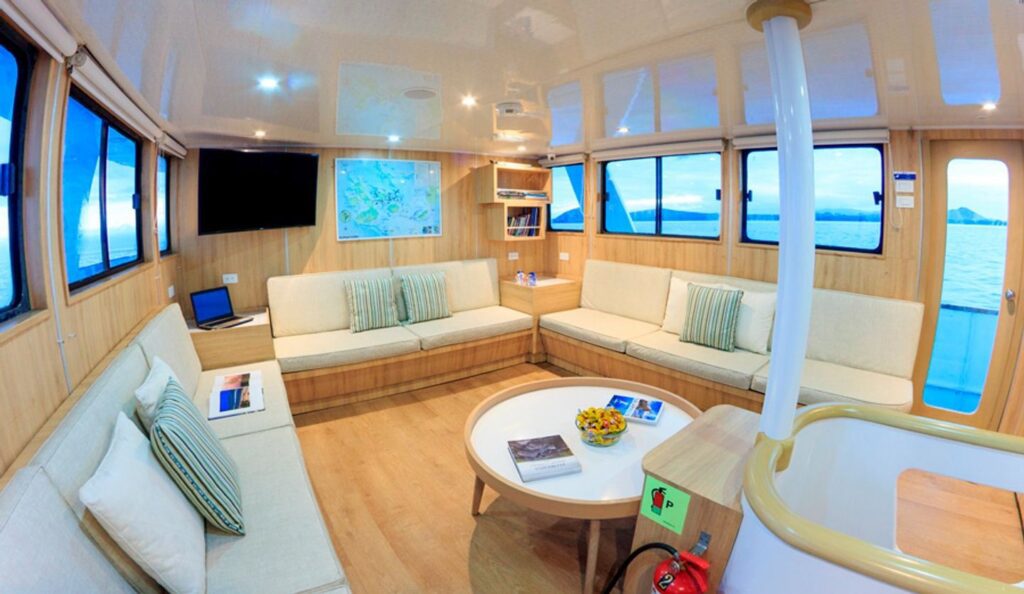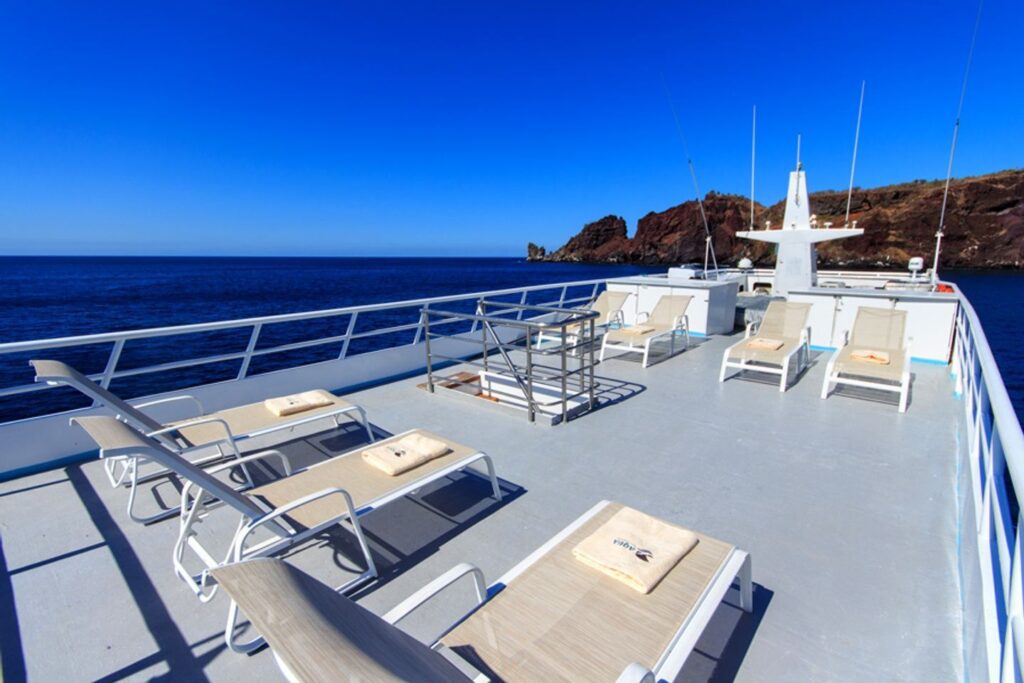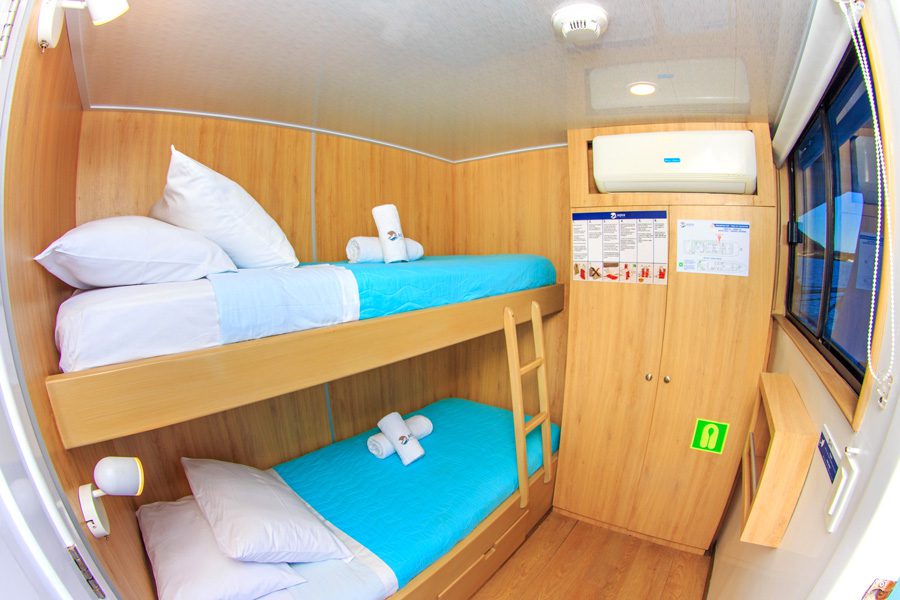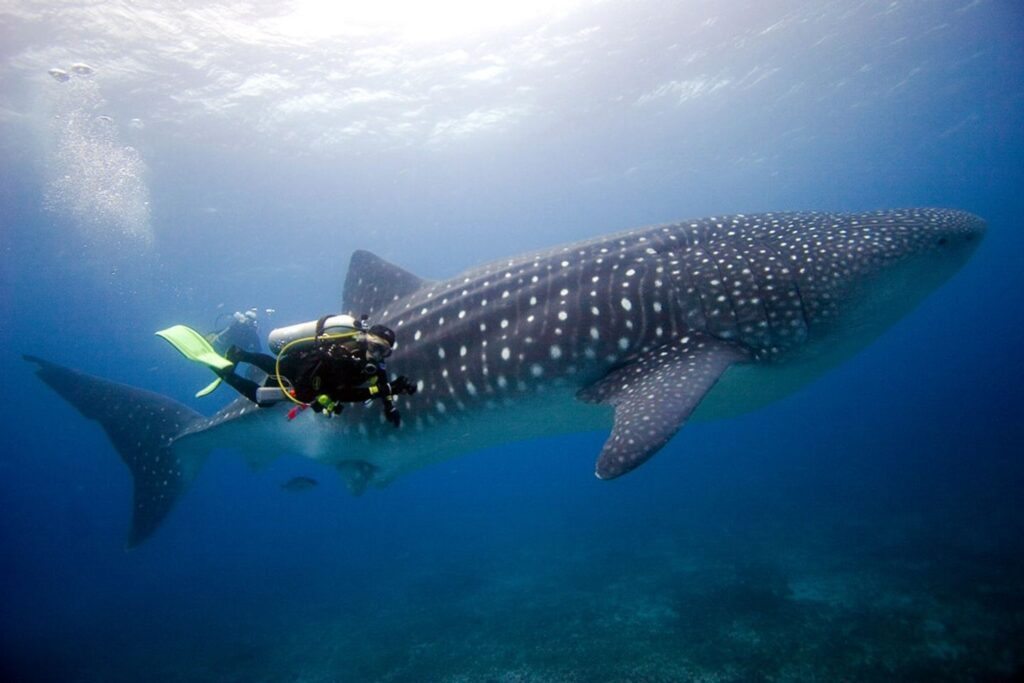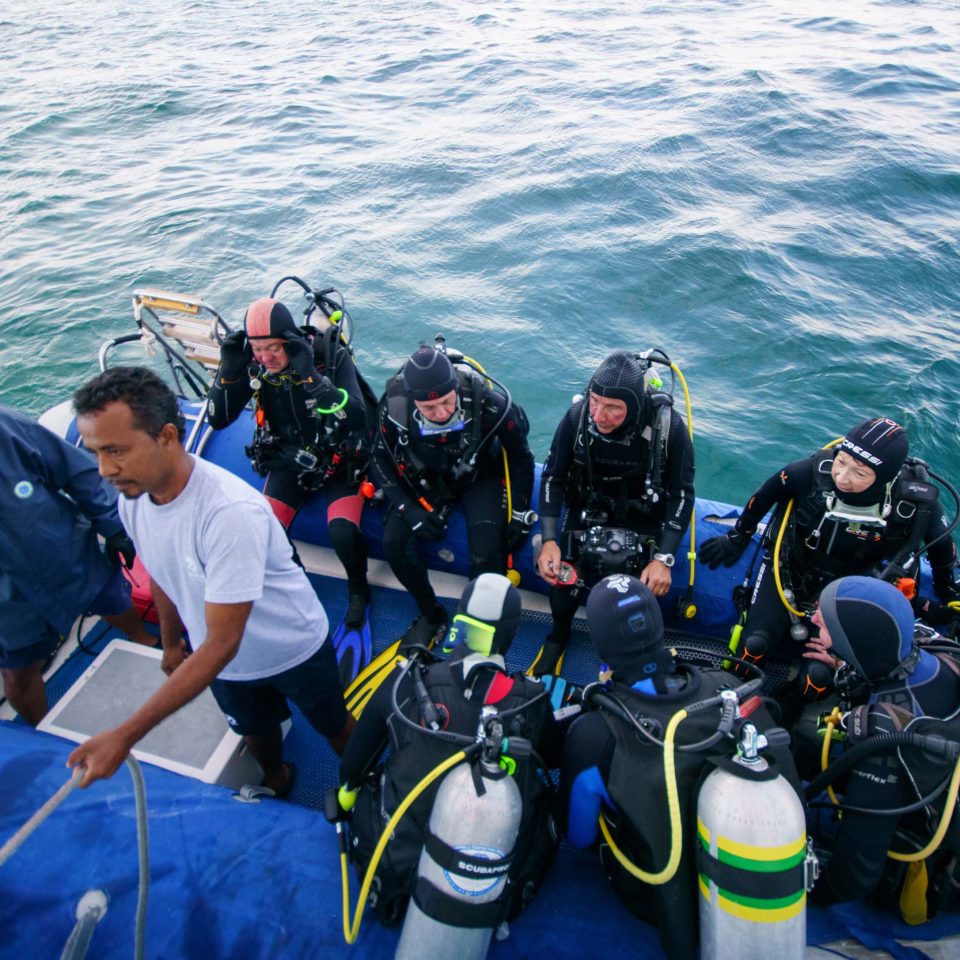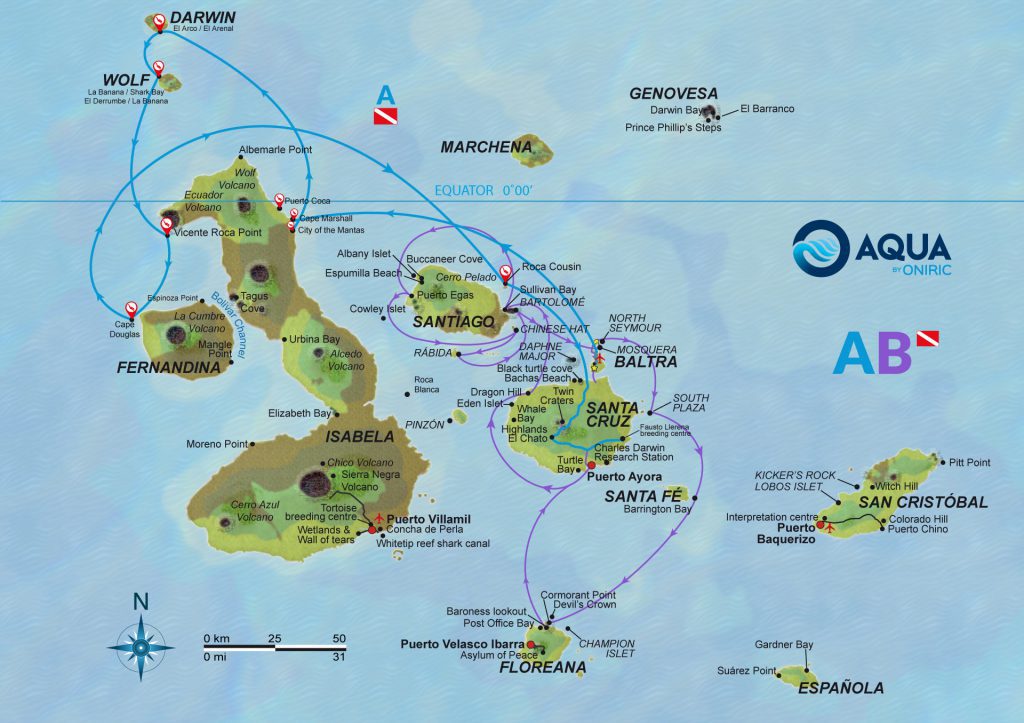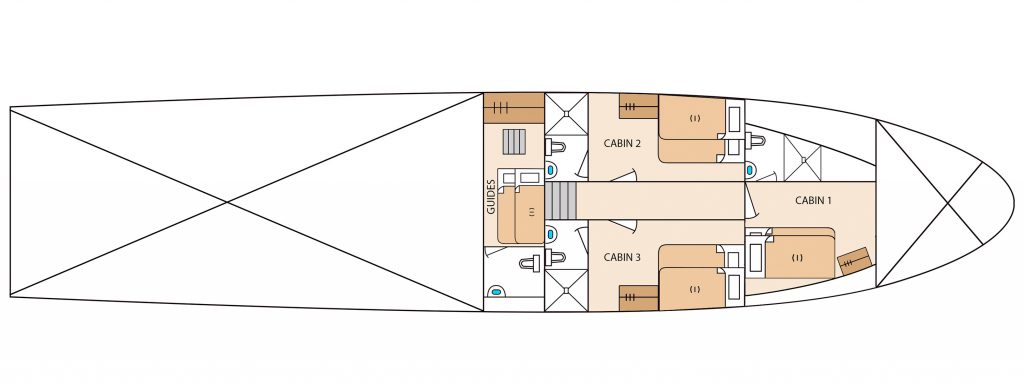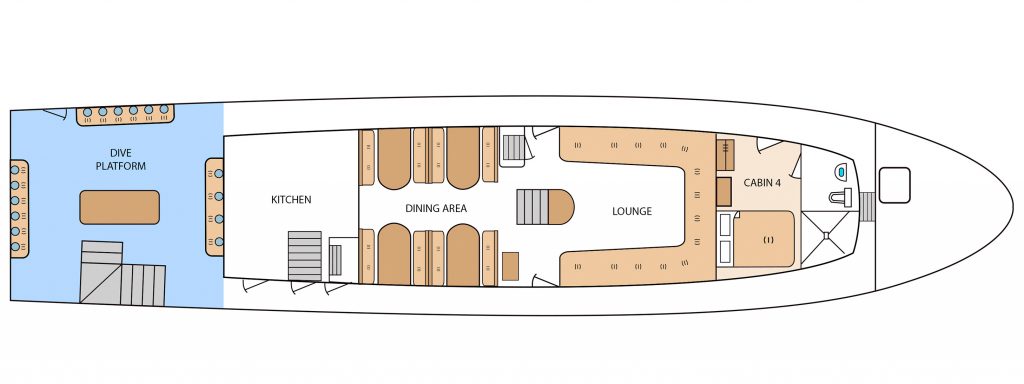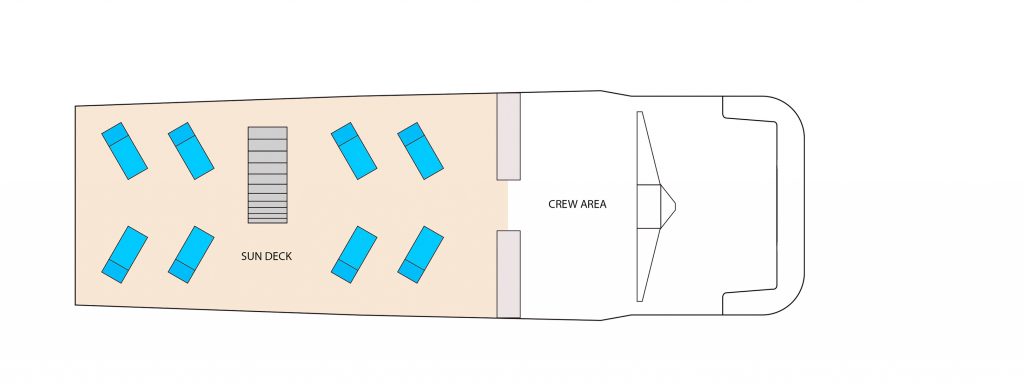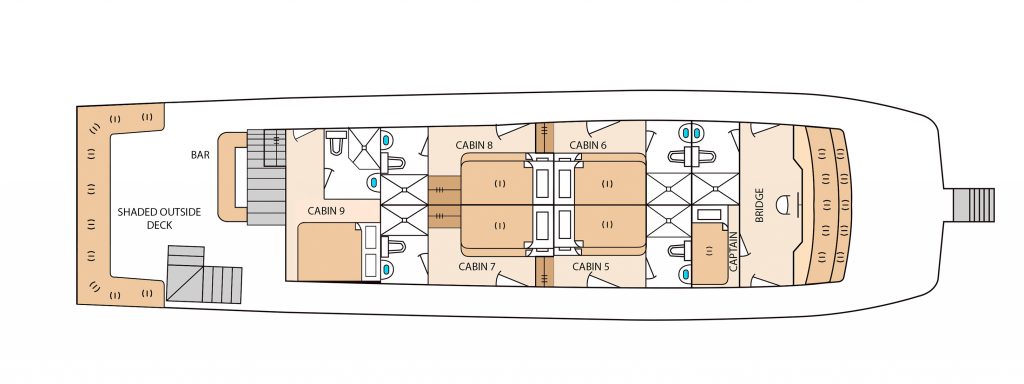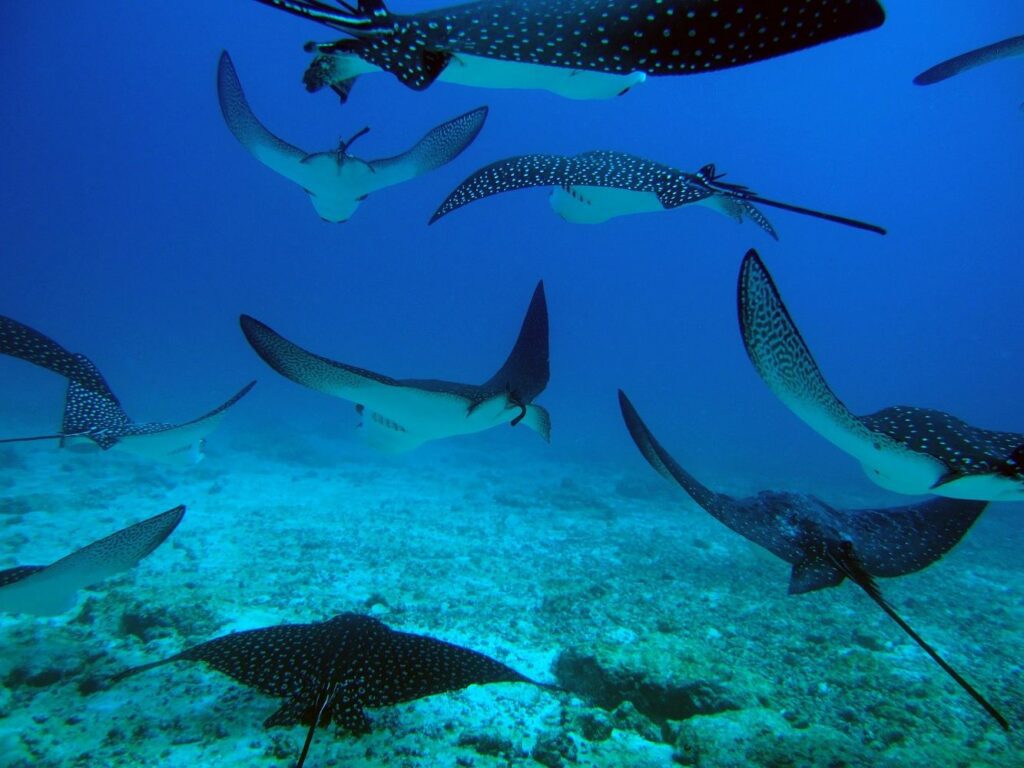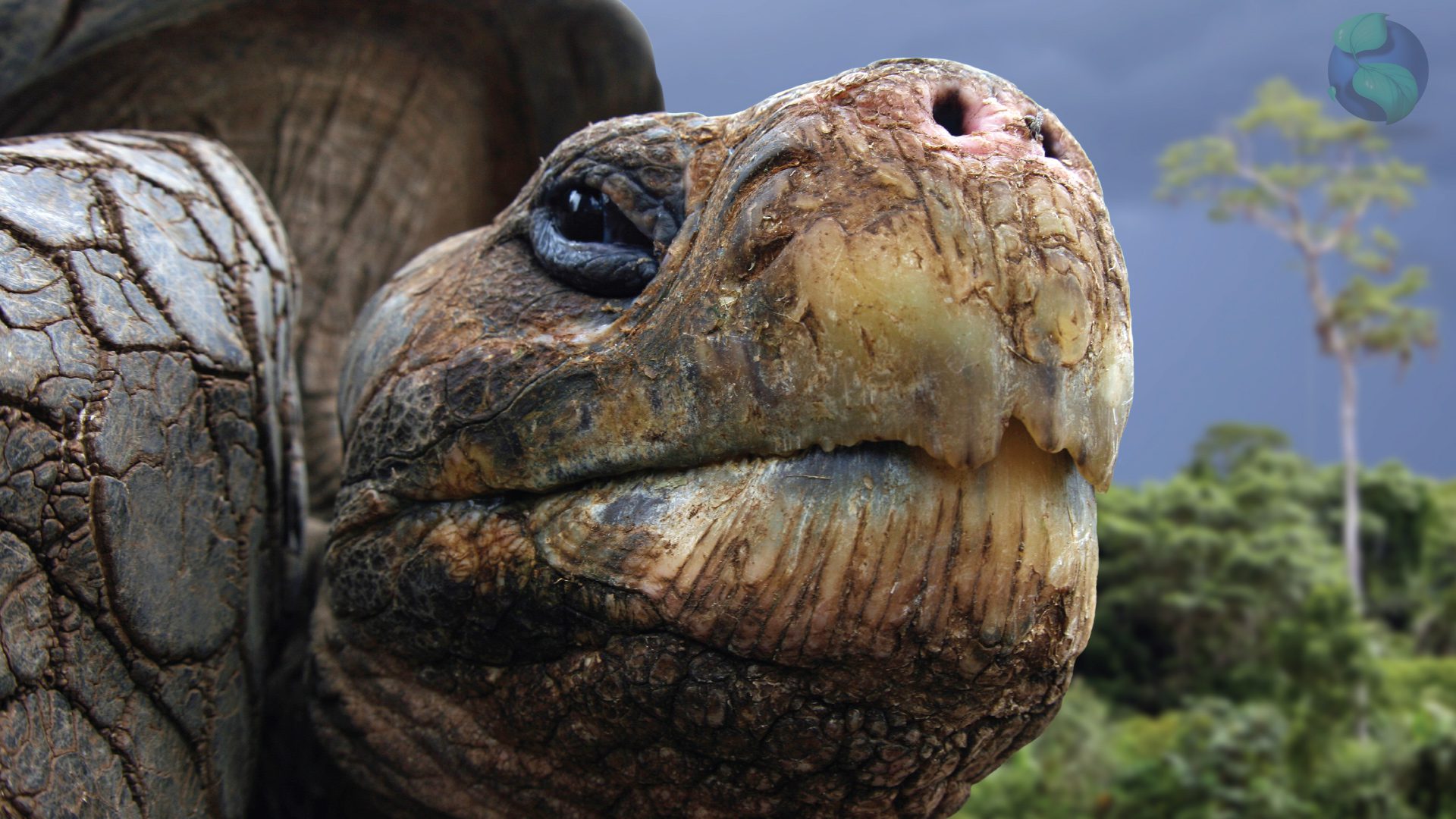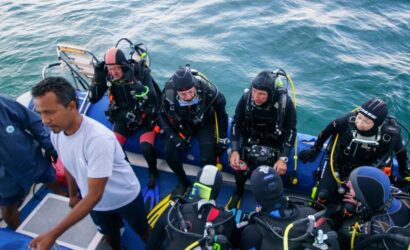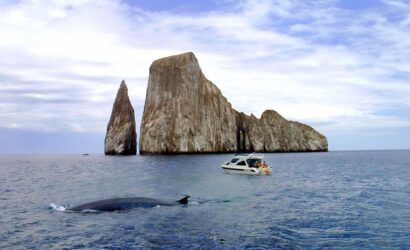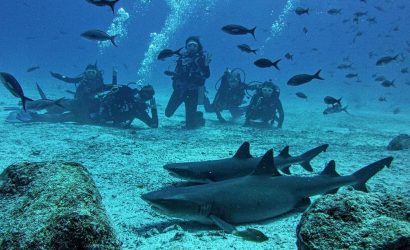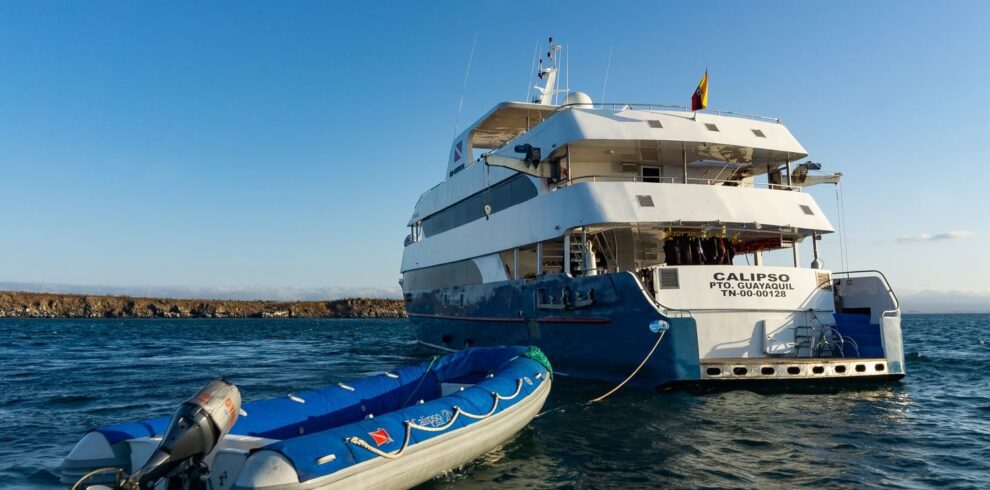Aqua is a comfortable and adventurous expedition boat and diving live aboard! It has a capacity of 16 guests and 8 crew members, including 1 diving instructor guide and 1 divemaster guide. Our cozy social areas consist of a library, a shaded outside lounge, a solarium, and dining areas where you can relax and enjoy the nature that will surround you.
Tour Overview
Starts/Ends Baltra
AQUA YACHT – COMFORT CATEGORY – 8-DAY DIVING TOUR – 19 dives
Aqua is a comfortable and adventurous expedition boat and diving live aboard! It has a capacity of 16 guests and 8 crew members, including 1 diving instructor guide and 1 divemaster guide. Our cozy social areas consist of a library, a shaded outside lounge, a solarium, and dining areas where you can relax and enjoy the nature that will surround you.
Visit the most exceptional diving sites in the unique Galapagos Islands. Few people get to see what lies beneath it and now is YOUR chance! We have created an exclusive diving itinerary to the most incredible locations all around the Archipelago. The wide variety of diving sites will ensure that you never experience the exact same marine life more than once!
Motor yacht Aqua will navigate around the breathtaking outdoors of the unique Galapagos Archipelago. We will take you to only the best areas around the islands so you can see the most incredible wildlife below the waves. Every day we will anchor at two selected visitor’s sites and organize at least two excursions.
You will observe marine life from different perspectives with our balanced excursion program and even amazing birdlife during your spare time!
Are you ready to see evolution happening right before your eyes?
- Dive into a magical world of pure uniqueness!
- Witness incredible marine life, including the whale shark!
- Swim with tropical fish, marine iguanas, and even friendly sharks.
- Visit the best diving sites in the Galapagos, including Darwin’s Arch, Cousin’s Rock, and more!
MAP OF THE JOURNEY:

Important Notes
- The itinerary is subject to change in case of unforeseen situations or requests by the national park.
- Please note that we cannot guarantee encounters with specific elusive species.
- Solo travelers are allowed to book a twin cabin on a shared basis. The cabin will be shared with another traveler of the same gender.
Itinerary - 8 Days
Tuesday: Arrival at Baltra Airport and NE Baltra (1 dive)
AM-Baltra Airport: Upon arrival at Seymour Ecological Airport, your guide will meet you at the airport, assist you with the luggage, and take you on a short bus ride. Then you will get on board the Aqua yacht, where the crew and captain will greet all passengers. Your cabin will be assigned and then you can check any rented diving gear. Afterward, the guide will begin the briefing about safety and activity details, as well as the afternoon’s dive. Finally, you will enjoy your first lunch on board.
PM-North East Baltra: This is the perfect spot to start your adventure with moderate currents. This dive site is for adventurous divers looking to see fascinating lava and rock formations, as well as marine species. At a depth of about 20m/60 ft, we might see white-tip reef sharks, pelagic sharks, reef sharks, rays, and turtles. Additionally, sea lions will be your companions upon entry and on safety stops. Occasionally, hammerhead sharks can be spotted swimming nearby.
(-/L/D)
Wednesday: Cape Marshall and City of Mantas (3 dives)
AM - Cape Marshall: Cape Marshall is located on the northeastern coast of Isabela island. This area offers drift diving and also an almost vertical wall of volcanic rock that falls all the way to the bottom of the sea. This is a great location for spotting hammerhead, white-tipped, and Galapagos sharks. Occasionally, whale sharks can also be seen. There are huge schools of black-striped salema and large schools of barracudas. You can also see black coral growing along the volcanic wall.
PM - City of Mantas: The main attraction of Cape Marshall is a hotspot to see giant mantas called "the City of Mantas". They come to feed on plankton-rich waters, which is why visibility can be low. After returning aboard the Aqua, the navigation to Darwin Island will begin.
(B/L/D)
Thursday, Friday, and Saturday: Darwin and Wolf Island (11 dives)
Due to a large number of dive sites available at Darwin and Wolf as well as the marked influence that marine conditions can have on the area, the dive sites will be chosen with these factors in mind. The guide will talk with all passengers in advance to inform them about the location, expected conditions, and alternatives of each site, and learn about their interests. On Friday, the fourth day of the expedition, conditions may be suitable for night diving in one of the two available locations. The regular options include the following:
Darwin’s Arch (Darwin): Though being one of the eye-catching landmarks of the Galapagos Islands, only a few can truly admire the sculpture of Darwin’s Arch themselves. The monumental arch has a hidden treasure underneath. It is an outstanding hotspot for schools of scalloped hammerhead and, particularly, whale sharks. Almost all whale shark encounters happen frequently between June and November around this arch in the far north of the Galapagos, where often-pregnant females make a brief stop-over during their mysterious solitary migration, with remora suckerfish as their sole fellow travelers.
Darwin’s Theatre (Darwin): Beneath the splashing waves, curved shelves bend around the northern branch, which is illustratively called “Darwin’s Theatre”. It features a genuine grandstand with panoramic hangouts at about 18 m/60 ft, right above the edge of the deep drop-off wall. The endless parade of extraordinary marine fauna includes hammerhead sharks schools, Galapagos sharks, silky sharks, and likewise, hunting yellow-fin tunas, wahoos, bonitos, amberjacks, as well as massive pelagic schools that transform into whirling bait balls when hunted.
El Arenal (Darwin): Sharks, turtles, and jacks visit cleaning stations all around Darwin’s Arch, to be freed from parasites. They maintain an incredible symbiotic relationship with the resident barber fishes and king angelfishes. The busiest area is usually the sandy slope right in front of the arch, known as “El Arenal”. We might see creole fish, hammerhead sharks, Pacific green turtles, rare hawksbill turtles, garden eels, and plenty of colorful starfish. Located only 100 m/110 yd around the corner of Darwin’s Theater, there are new lifetime opportunities to swim with majestic whale sharks, or to wonder about all marine life that comes with the flow. Depending on the season we might also see bottlenose dolphins, Mobula devil rays, and giant oceanic mantas.
(B/L/D)
Thursday, Friday, and Saturday: Darwin and Wolf Island (11 dives)
Due to a large number of dive sites available in Darwin and Wolf as well as the marked influence that marine conditions can have on the area, the dive sites will be chosen with these factors in mind. The guide will talk with all passengers in advance to inform them about the location, expected conditions, and alternatives of each site, and learn about their interests. On Friday, the fourth day of the expedition, conditions may be suitable for night diving in one of the two available locations. The regular options include the following:
Shark Bay (Wolf): Located on the east coast of Wolf, it is shallower than most sites around, yet for many the most memorable. Besides being another spot where sharks are galore, local cleaning stations reveal fascinating symbiotic relationships. Critically endangered hawksbill and Pacific green turtles visit busy king angelfishes. Cleaner fishes also groom spotted eagle rays and even hammerhead sharks. In these shallows, individual male hammerheads tend to approach motionless divers closer than schooling females in open water do. Their reluctant character is quite opposite to the curious Galapagos sea lions, that immediately look for company and love to interact!
The Landslide (Wolf): The Landslide is Wolf's premium diving spot. Hammerhead sharks circle around or head against the current, as well as well-camouflaged scorpionfishes, abundant white-spotted moray eels, and whitetip reef sharks. Some pavona corals are an example of Indo-Pacific influences around these northern islets. Galapagos requiem sharks, pelagic schools, and many more species that are easily overlooked in these surroundings. Whistles indicate that bottlenose dolphins are near. The hot season usually brings lots of Pacific green turtles, majestic formations of spotted eagle rays, and, if lucky, Mobula devil rays and giant oceanic mantas.
The Pinnacle and The Caves (Wolf): This area has some of the best caves in the Galapagos and an exciting experience at The Pinnacle. It has four underwater caves that penetrate into the wall of the islet and are easily accessible. All the entrances to the caves are at depths of 15-21 m/50-70 ft. Hawksbill and green turtles usually gather in this area, hanging around the opening. The large variety of life around and in the caves includes schools of soldierfish, guineafowl puffers, moray eels, whitetip reef sharks, marble rays, cardinalfish, and lobsters hiding in holes and cracks.
The dive ends in the northeastern corner of Wolf at a tall and massive underwater pinnacle, of which the top is barely below the surface of the water. If the currents allow it, you can swim across the gap to the pinnacle, grab on, and watch the bubbles to see how the currents are behaving. Here you can watch out for large pelagic species, like hammerhead and Galapagos sharks, bottlenose dolphins, and turtles.
The Secret Cave - Night dive (Wolf) The Secret Cave has its origins in gas chambers that date back to the formation of the island that eroded and collapsed with the passing of time. It is a great alternative on the northern side of Wolf if the conditions allow you to dive here. Along the wall, sometimes with hammerheads, we find the entrance into a cave that may reveal several nocturnal species, such as cardinal fishes, spiny lobsters, shrimps, colorful sea urchins, hunting moray eels, as well as Pacific green turtles and sea lions.
Anchorage - Night dive (Wolf) The Anchorage of Wolf is the only dive site located on its sheltered west coast. The cove and surrounding cliffs reveal outlines of the former main crater of this extinct volcanic islet. Some sharks and reef fish may be spotted at the surface, as well as blue-footed boobies. Those who dare another, quite different adventure, may opt for a dark and exciting night dive. Right beneath the anchored yacht, walks and hops the weird red-lipped batfish with its leg-fins on the 20 m/70 ft deep sandy bottom. Though active at night and attracted by your light’s beam, this chilly activity probably won’t be the only opportunity to marvel at this endemic Galapagos species.
(B/L/D)
Thursday, Friday, and Saturday: Darwin and Wolf Island (11 dives)
Due to a large number of dive sites available in Darwin and Wolf as well as the marked influence that marine conditions can have on the area, the dive sites will be chosen with these factors in mind. The guide will talk with all passengers in advance to inform them about the location, expected conditions, and alternatives of each site, and learn about their interests. On Friday, the fourth day of the expedition, conditions may be suitable for night diving in one of the two available locations. The regular options include the following:
Shark Bay (Wolf): Located on the east coast of Wolf, it is shallower than most sites around, yet for many the most memorable. Besides being another spot where sharks are galore, local cleaning stations reveal fascinating symbiotic relationships. Critically endangered hawksbill and Pacific green turtles visit busy king angelfishes. Cleaner fishes also groom spotted eagle rays and even hammerhead sharks. In these shallows, individual male hammerheads tend to approach motionless divers closer than schooling females in open water do. Their reluctant character is quite opposite to the curious Galapagos sea lions, that immediately look for company and love to interact!
The Landslide (Wolf): The Landslide is Wolf's premium diving spot. Hammerhead sharks circle around or head against the current, as well as well-camouflaged scorpionfishes, abundant white-spotted moray eels, and whitetip reef sharks. Some pavona corals are an example of Indo-Pacific influences around these northern islets. Galapagos requiem sharks, pelagic schools, and many more species that are easily overlooked in these surroundings. Whistles indicate that bottlenose dolphins are near. The hot season usually brings lots of Pacific green turtles, majestic formations of spotted eagle rays, and, if lucky, Mobula devil rays and giant oceanic mantas.
The Pinnacle and The Caves (Wolf): This area has some of the best caves in the Galapagos and an exciting experience at The Pinnacle. It has four underwater caves that penetrate into the wall of the islet and are easily accessible. All the entrances to the caves are at depths of 15-21 m/50-70 ft. Hawksbill and green turtles usually gather in this area, hanging around the opening. The large variety of life around and in the caves includes schools of soldierfish, guineafowl puffers, moray eels, whitetip reef sharks, marble rays, cardinalfish, and lobsters hiding in holes and cracks.
The dive ends in the northeastern corner of Wolf at a tall and massive underwater pinnacle, of which the top is barely below the surface of the water. If the currents allow it, you can swim across the gap to the pinnacle, grab on, and watch the bubbles to see how the currents are behaving. Here you can watch out for large pelagic species, like hammerhead and Galapagos sharks, bottlenose dolphins, and turtles.
The Secret Cave - Night dive (Wolf) The Secret Cave has its origins in gas chambers that date back to the formation of the island that eroded and collapsed with the passing of time. It is a great alternative on the northern side of Wolf if the conditions allow you to dive here. Along the wall, sometimes with hammerheads, we find the entrance into a cave that may reveal several nocturnal species, such as cardinal fishes, spiny lobsters, shrimps, colorful sea urchins, hunting moray eels, as well as Pacific green turtles and sea lions.
Anchorage - Night dive (Wolf) The Anchorage of Wolf is the only dive site located on its sheltered west coast. The cove and surrounding cliffs reveal outlines of the former main crater of this extinct volcanic islet. Some sharks and reef fish may be spotted at the surface, as well as blue-footed boobies. Those who dare another, quite different adventure, may opt for a dark and exciting night dive. Right beneath the anchored yacht, walks and hops the weird red-lipped batfish with its leg-fins on the 20 m/70 ft deep sandy bottom. Though active at night and attracted by your light’s beam, this chilly activity probably won’t be the only opportunity to marvel at this endemic Galapagos species.
(B/L/D)
Sunday: Vicente Roca Point and Cape Douglas (2 dives)
AM-Vicente Roca Point (Isabela): Punta Vicente Roca is located on the northwestern side of Isabela just below the seahorse's ‘mouth’. The cave's calmer waters are well protected from the ocean swell and are a great place to dive amongst various species of sharks, penguins, pufferfish, and even seahorses. Encounters with sunfish are also very common.
PM-Cape Douglas (Fernandina): Cape Douglas provides you with incredible opportunities to observe an abundance of marine life, above and below the water. As you prepare for the dive, you can see Galapagos penguins, flightless cormorants, and Galapagos marine iguanas, animals that are only found exclusively on these islands. We will also go looking for incredible marine iguanas swimming and feeding on the rocks below the surface. Some of the marine life forms you can see are the red-lipped batfish, horned shark, sunfish, and possibly whales!
(B/L/D)
Monday: Cousin's Rock and Santa Cruz Highlands (2 dives)
AM-Cousin’s Rock (Santiago): The lone, symmetrical pyramid of Cousin’s Rock sticks just above the coastal waters of Santiago, approximately 5 km/3 mi north of Bartolome Islet. We might see blue-footed boobies, brown pelicans, Galapagos fur seals, sea lions, and seasonally Galapagos penguins, which can be spotted during a dinghy ride around. The actual drop-off points around Cousin’s Rock and dive directions depend on the turning currents and local currents around these Enchanted Islands. Normally, you will be diving twice in one of these sites. This spot is mostly a reef dive. Low visibility usually means an abundance of plankton, which brings a large number of small and pelagic fish and, with them, large animals.
PM- Santa Cruz Highlands: The native scalesia forest of El Chato Tortoise Reserve is the best place to look for Galapagos giant tortoises in their most authentic setting! Despite the interesting breeding centres –where you are guaranteed to find tortoises– there is nothing better than to observe them in their wild environment. Unlike the adjacent agricultural zone, El Chato Giant Tortoise Reserve is a protected area and official part of the Galapagos National Park. It extends from Cerro El Chato as far down as the southwestern coast of Santa Cruz Island, where females follow Darwin's “tortoise highways” to lay their eggs. Besides tortoises in El Chato Giant Tortoise Reserve, there is also a native scalesia forest to be appreciated, overgrown with lichens, ferns, and other epiphytes. This protected area provides excellent chances to spot numerous endemic songbirds between the dense foliage, relishing the delicacy of introduced blackberries, including Darwin's finches, vermilion flycatchers, and yellow warblers. In the tortoise pond are also aquatic birds, including the paint-billed crake.
(B/L/D)
Tuesday: Baltra
AM-Transfer to Baltra Airport: It’s time to say goodbye to Galapagos! Assisted by the naturalist guide and some crew members, the dinghy will bring you and your luggage to the Seymour Ecological Airport, where you will take the shuttle back to the airport.
(B/-/-)
Prices
$4,595
Adults share a cabin on the lower deck. Lower deck cabins have portholes instead of picture windows.
$4,795
Adults share a cabin on the upper deck. Upper deck cabins have picture windows that can be opened.
$6,892
Single travelers who prefer not to share a cabin with a designated same-gender traveler. Lower deck cabins have portholes instead of picture windows.
$7,192
Single travelers who prefer not to share a cabin with a designated same-gender traveler. Upper deck cabins have picture windows that can be opened.
|
|
Includes/Excludes
Includes
- Accommodation is confirmed.
- All mentioned meals (full board), filtered water, tea, and coffee.
- All excursions and activities as mentioned in the itinerary, are guided by a National Park certified naturalist guide.
- Beach towels and snorkeling gear (snorkel, mask, and flippers). Wetsuits are also available for rent.
Excludes
- Round-trip flight to the Galapagos.
- Soft and alcoholic drinks.
- Galapagos National Park entrance fee and Transit Control Card (currently USD 100 and 20, respectively, and subject to change).
- Personal travel insurance.
- Personal expenses, extras, and tips.

